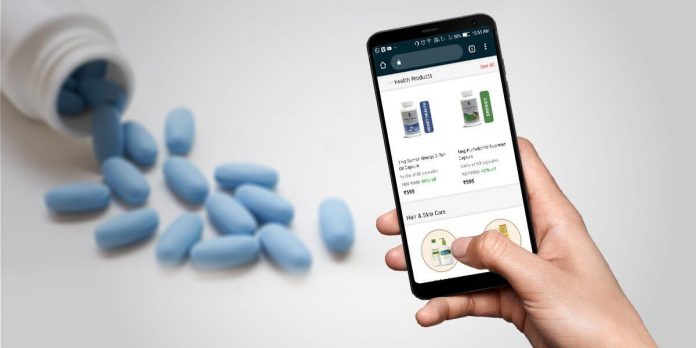This article is penned by Sarthak Gupta, from Institute of Law, Nirma University. This is a comprehensive article about the elaboration of E-pharmacy and its regularities.
Table of Contents
Introduction
E-Pharmacy is a type of pharmacy that operates in the digital era through the internet and delivers the medicines to the customers through mails or dedicated delivery companies. Independent Internet-only outlets, electronic subsidiaries of “brick-and-mortar” hospitals, and platforms serving pharmacy companies come under the category of “online pharmacies”. Contemporary times are seeing a spike in e-commerce, including online shopping, including the selling of prescription and non-prescription medicines. The idea of electronic pharmacy and the selling of drugs online has been in vogue around the world for more than two decades.
As India’s pharmaceutical trade began slowly to shift from offline to online at the turn of this decade, the concept of E-Pharmacy caught the attention of regulators and the Union Health Ministry in July 2015 created an expert committee to determine the viability of online pharmacy in the country under the chairmanship of the then Maharashtra FDA Commissioner Dr Harshdeep Kamble. After lengthy Consultations, on 28 August 2018, the Union Health Ministry released a detailed collection of the draft regulations to amend D&C Rules by adding separate sections for governing online pharmacies in the nation. Since then, the issue has been embroiled within the ministry’s bureaucratic circles. Concerned at the delay in finalizing the regulations, the country’s top association of industry organizations, FICCI, strongly urged timely notification of e-pharmacy regulations in January (2020) to prevent misunderstanding among stakeholders. The national trading body argued that the delay in notifying e-pharmacy regulations is creating a lot of problems for e-pharmacy players as an easy and straightforward regulatory direction is a requirement for innovation to succeed in this significant industry. Recently, Dr B R Jagashetty, a sector specialist and former CDSCO National Advisor (Drugs Control), has emphasized the need for the hour for e-pharmacies and urged the government to come out as early as possible with the final e-pharmacy regulations.

Current rules and regulations of e-pharmacies
There is currently no regulatory mechanism for the online sale of drugs in the country, and the laws governing the brick-and-mortar pharmacy sector extend to e-pharmacies as well. The Drugs and Cosmetics Act does not differentiate between the internet and traditional drug transactions. Given that the existing laws are vague on this issue, e-pharmacies are selling rampant prescription drugs in contravention of the prevailing laws, which can prove to be dangerous to patients. There is no distinction between online and offline pharmacy in Indian Pharmacy law, however, there is a set of certain guidelines mentioned in the Indian Pharmacy Legislation. According to the Drugs and Cosmetics Act, 1940 (DCA) and Drugs and Cosmetics Rules, 1945 (DCR), all Rx medication (those medications that can be dispensed with a valid prescription only) is compulsory for sale in India. Any pharmacy retail/shop shall obtain a license pursuant to Section 18 of the Drugs and Cosmetics Act and Rule 61 of Drugs and Cosmetics Rules, 1945 to carry on the selling of prescribed medications only on a legitimate prescription of a registered physician (RMP) as specified in Section 42 of the Pharmacy Act, 1948. Only licensed pharmacists whose license to dispense pharmaceutical products according to the Drugs and Cosmetics Regulations Rules, 1945, and Section 9 of the Pharmacy Practice Regulations, 2015 has been granted by a specific Indian state drug authority. E-Pharmacy in India is in modicum and is pursued under the Drugs and Cosmetics Act, 1940, and the Information Technology Act, 2000. However, online sales of the prescription based medicines from E-Pharmacy’s website are defined under the Information Technology Act, 2000.
IIPA (Indian Interest Pharmacies Association), now known as Digital Health Platform, is an Indian group of online pharmacies and businessmen in the health sector. According to Digital Health Platforms, the guidelines adopted by alliance leaders such as 1 mg, M-Chemist, Netmeds, Pharm Easy to name a few and other main players in electronic pharmacies to offer Rx drugs digitally are, No selling without a legitimate RMP (Registered Medical Practitioner) prescription; No sale of drugs under Schedule X (drugs based on narcotics and psychotropic substances). Full wrapping under the personal control of the licensed pharmacist of the pharmacy with a tamper-proof label. Valid invoice for each order or sale of a medicinal product. Facilitate the recall of medicines in cases directed by the Government of India. The IIPA also works closely with the Indian Government to implement legislative reforms, including the use of the AADHAAR UID number to be related to medications to ensure that drugs are not misused electronically.
Advantages of e-pharmacies
E-Pharmacies turn out to be efficient in many ways.
- Patients or customers can conveniently order their prescribed medicine directly through their mobile phones and computers, that aids particular elder/ old patients who can’t get on their own. This is also beneficial for nuclear families, working tier 1 city couples who don’t have enough time to search for offline pharmacy.
- E-pharmacies are not only limited to urban cities, but they can also allow access to rural areas, where there is a limitation of retailed pharmacy.
- E-Pharmacies also play an important role in providing adequate information to the customer about the individual drug, such as reactions of the medication, side effects, usage, and other important precautions.
- With the technology’s diversity, all actions of E-Pharmacy can be monitored, from its batch number, address, doctor prescription, patient name, and address which can help to reduce drug abuse.
- E-Pharmacy allows the channel from the manufacturer, supplier of counterfeit, fake drugs to trackback, making the industry of healthcare more broad and open. All the drugs ordered can be looked up through the prescription which goes for authentication, kept in records via the order ID of the patient or customer.
- E-Pharmacies also take care of the cold-chain drugs which are subjected to 2-8 celsius storage temperature, in boxes specifically made for storing these drugs, which helps to maintain the consistency of insulin, hormones, and other blood-related products for a longer period of time.
- While at the neighbourhood retail pharmacy, costs are generally fixed and near the Maximum Retail Price (MRP). Because of lower working expenses and higher rivalry, E-pharmacy gives the purchasers the adaptability to look at costs and browse numerous providers.
Role of e-pharmacies during the lockdown
Indeed, even as the whole 1.3 billion residents in the nation are remaining inside because of the lockdown declared by the administration to contain the spread of exceptionally irresistible coronavirus illness, there can be no preferred time over this when the individuals felt the critical requirement for the administrations of e-pharmacy in the nation. While individuals are competing with one another to arrange all the things under the sun through internet business to keep the truly necessary social removing in the dread of COVID-19, a similar web-based business administration isn’t lawfully accessible to the lakhs of patients in the whole expansiveness and length of the nation, on account of the extreme postponement in settling a lot of rules on e-pharmacy by the legislature. Although e-pharmacy, which has been established as an important service, is returning to usual, players working in this area believe another period of chaos and limitations may be found once again after the prolonged shutdown.
However, because of the COVID-19 lockout, customers tend to buy medication online. By enforcing lockdowns, monitoring, exclusion, and care, states are taking all the necessary measures to protect lives. Around the same time, but for the supply and purchase of vital goods and services, limiting outside travel too. E-commerce’s role in both wholesale and retail trade is steadily increasing. E-commerce firms have experienced an increase of around 20-30 per cent in orders.
Scenario in other countries
Developed countries such as the United States, Canada, Australia, and European countries have legitimate internet-based daily bodies such as NABP (National Association of Pharmacy Boards), which is specified by government-verified internet pharmacy sites such as VIPPS. Such E-Pharmacy websites can be identified by the hyperlink seal that is shown on the E-Pharmacy website home page, whether false or actual. The pharmacies (online or offline) are regulated at the state level in the United States, although there is no licensing process at the federal level. So, there are slight variations between the various states in licensing laws. Online pharmacies can operate in the country, with the following limitations: Importation of prescription drugs is illegal in the US according to the Food and Drug Administration (FDA) rules. Therefore all pharmacies online must be physically located throughout the region. However, Across the United Kingdom, more than 2 million customers routinely purchase drugs from internet retailers on the Internet; some are legal, but some have “dangerous activities” that may place children at risk. In 2008, the Royal Pharmaceutical Society of Great Britain (RPSGB) launched a green cross logo to better distinguish licensed online pharmacies (GPhC has been using the Internet pharmacy logo since 2010). Registered European pharmacists have reciprocal agreements that allow them to practice in the UK by registering with the General Council of Pharmacy.
Indian government should also develop certain kinds of the standard system from which it is possible to discern genuine and false e-pharmacies in India. Days are not far from the Indian government embracing the US, British, and European e-pharmacies model because it will save consumer time and energy.
Issues involved
There are two major issues that come with e-pharmacy which need to be explored. One is the administrative test and the other issue is being the test in giving an important incentive to the populace section it plans to serve. In India, Indian pharmacy legislation comprehensively expresses that medications ought to be sold distinctly through a legitimate prescription and apportioned through an enlisted pharmacist. Be that as it may, a patient can buy medicine without a remedy from a retail pharmacist. Regardless of whether the purchase is made with a valid prescription, there is no record kept up. In addition, while the pharmacy may have an enlisted pharmacist on paper, the individual keeping an eye on the counter and apportioning medicine is once in a while the enrolled or registered pharmacist. Even if the purchase is made with a prescription, there is no record maintained of the prescription at the chemist’s end. Moreover, while the pharmacy may have a registered pharmacist on paper, the person manning the counter and dispensing medicines is rarely the registered pharmacist. In E-Pharmacy, the prescription is stacked on the entry.
After the stacking of the prescription, they are checked by an enlisted pharmacist, and afterwards, at long last, the medication is administered and sent to the patient alongside the full receipt of cluster number and expiry date. This likewise assists with shielding against the patient accepting fake or false medications. This careful record-keeping of solutions and solicitations is additional protection for the pharmacy if there should arise an occurrence of any results of cases of inaccurate prescriptions administered. Along these lines, while the AIOCD is crying itself dry challenging the e-pharmacies, it might wind up in a spot if the legislature examines the adherence to pharmacy laws over the 8 lakh in addition to the brick and mortar retail pharmacist pan India.
Another Challenging issue is, Value Proposition Challenge, What is this hole in which the e-pharmacy is filling? Each online business in the web-based business space is based on the way of thinking of ‘traction before transaction’. This implies benefits are relinquished to guarantee clients change to these organizations. For the cost-cognizant Indian client, limiting is the most straightforward draw. The E-Pharmacy, particularly the greater ones are vigorously subsidized and henceforth the incentive offered by the vast majority of them is increasingly centred around investment funds on medication cost, extending from 10 to 25 per cent. The greater part of the correspondence in the commercials centres around investment funds. The subsidizing behind e-pharmacy makes this limiting simple to shoulder. This limit changed the recognition for the Indian clients that even medications could be accessible on limits.
Conclusion
The Indian e-pharmaceutical judiciary and regulatory authority should take into account the steps adopted by numerous other developing countries such as the USA and the EU with common logo labels, electronic monitoring programs, e-prescription for some medicines to tackle problems related to the online selling of medication in India. It is indeed clear in the present circumstances that e-pharmacies will be able to satisfy the unmet medical needs of a large section of the country’s people. So the government should come forth with the final e-pharmacy rules immediately. The faster the best for the nation’s ailing population.
References
- https://www.pharmatutor.org/articles/know-all-about-the-e-pharmacies-in-india
- https://www.medianama.com/2017/10/223-online-pharmacy-policy-united-states/
- https://www.sciencedirect.com/topics/medicine-and-dentistry/online-pharmacy
- https://www.ncbi.nlm.nih.gov/pmc/articles/PMC5155458/
- https://www.bloombergquint.com/business/coronavirus-outbreak-demand-spikes-for-online-grocers-and-pharmacies-amid-panic-buying
- https://www.bloombergquint.com/business/coronavirus-outbreak-demand-spikes-for-online-grocers-and-pharmacies-amid-panic-buying
- https://www.pharmatutor.org/articles/current-status-of-e-pharmacy-in-india-2019-review
LawSikho has created a telegram group for exchanging legal knowledge, referrals and various opportunities. You can click on this link and join:
 Serato DJ Crack 2025Serato DJ PRO Crack
Serato DJ Crack 2025Serato DJ PRO Crack










 Allow notifications
Allow notifications




Hi, I am glad that I have gone through such an astonishing post, Thanks for sharing !